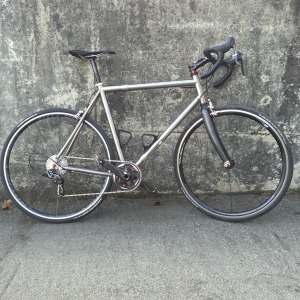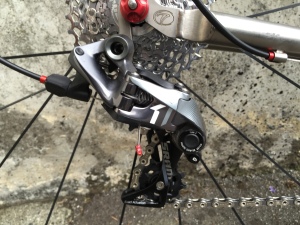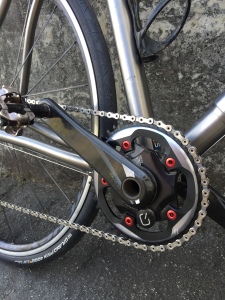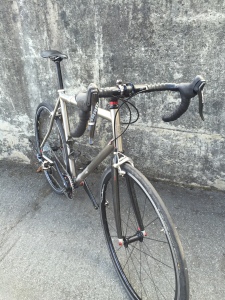Single Chainring Setup for Road Bike
|
I’ve been experimenting with a single chainring road bike and I’m very pleased with the results. I hope my experience will encourage others to try this simple and elegant setup. SRAM released the Force CX1 gruppo for cyclocross but I believe it’s well suited for road use. I wanted to try it on my travel bike with S&S couplers to simplify packing and assembly. SRAM uses two technologies to keep the chain from jumping off the chainring. The chainring teeth alternate between narrow and wide to fit more closely against the internal spaces in the chain, and the large rear derailleur uses a clutch and a very strong spring to hold the chain firmly in place. This strong spring could make wheel changes more difficult so SRAM added a nifty feature that locks the rear derailleur in a slack position for wheel changes if needed. Many riders may be hesitant to try this setup for fear of losing useful gear ratios at either end of the range, or having jumps between gears that are too large. For me, the 11 speed cassette with an 11-32 tooth range eliminates both these problems. Paired with a 44 tooth chainring, an 11 x 32 gives a high gear of 105.5 gear inches, exactly the same as a 52 x 13 (4 to 1 ratio), which was the largest gear that road riders used in the Merckx era. If it’s big enough for Eddy, it’s big enough for me. On the low end, a 44 x 32 gives a climbing gear of 36.3 inches, roughly equivalent to a 39 x 28 from a standard crankset or a 34 x 25 on a compact crankset. The largest jump between gears in the single ring setup is a 16% difference between the 19 tooth cog and the 22 tooth cog, similar to the 14% difference in a standard 39-53, 12-27 setup between the 21 and the 24. I have no trouble finding a comfortable cadence within these ranges and I never feel that I’m missing an in-between gear. For example, even bridging the biggest 16% gap in the gearing range, the rider can choose between a cadence of 80 or a cadence of 93, both of which are fine for me. Because I use this bike in some mountainous terrain I chose a 44 tooth cog to yield a forgiving climbing gear, but one could easily use a 46 tooth ring or even a 50 tooth ring (available from Wolf Tooth Components). Be sure to use only a narrow-wide chainring designed for single ring use – this limits choices to even numbered tooth sizes. Riders in flatter parts of the world could conceivably get away with a narrower cassette in the back, perhaps an 11-28 paired with a 46 or a 50 tooth ring, and have no large jumps at all in the cassette. With this setup you can easily adjust the gearing to suit your riding style and terrain by changing the front chainring. Doing so only requires unscrewing five bolts, and the SRAM chainring bolts have an improved 5mm-6mm allen key interface instead of the frustrating slot from conventional chainring bolts.I find that swapping chainrings is actually easier than changing cassettes. One limitation in swapping chainrings is chain length. My chain length works with a 40, 42, or 44 tooth chainring but if I went larger than 44 teeth I might have to adjust the length of the chain. I carry a 40 tooth chainring with me when I travel in case I’m tackling something extraordinarily steep. SRAM recommends only using their 11-speed chain with the system, and the SRAM master link is not easily removable, so until Wipperman comes out with an 11-speed master link, adjusting the chain length is not a trivial task. On the road this system works beautifully. The strong spring and clutch on the rear derailleur combined with the narrow-wide chainring teeth prevent the chain from jumping off. Shifts are fast and the chain runs quietly and very smoothly, even in the extreme gears. Chain line doesn’t seem to be a problem. Never having to endure a clunky and awkward front derailleur shift is a pleasure. Overall this setup is slightly lighter than the SRAM Red double ring 10-speed that it replaced. The 290 gram cassette is significantly heavier than the very light Red cassette, and the rear derailleur is beefy at 260 grams, but I eliminated the front derailleur entirely along with a chainring, the internals of the left shift lever, cables and housing. All in all the single ring setup is 10 grams lighter than 10-speed Red, and the difference would have been about 70 grams if I hadn’t been using the ultralight Red cassette. SRAM offers a brake lever without shift elements, in both aluminum and carbon, for use with this system, and its shape and ergonomics are identical to the right hand 11-speed lever. You could also just use a normal double tap left lever, or you could remove the double tap internals from a left lever. Here’s a cool feature – it turns out that all road and ‘cross SRAM shifters use the same cable pull, so although this system was designed for 11 speed bikes, if you have existing SRAM 10 speed you could easily use the 1×11 rear derailleur and chainring with your existing 10 speed and avoid the cost of new shifters. You lose a gear somewhere in the range but it’s great to have compatibility and options. There are a few disadvantages to this setup. The most obvious one is that the system doesn’t provide quite the same gear range as a two-ring setup, especially one of the wider range ones like a WiFli or a compact crank with an 11×28. In addition, SRAM offers this system only in the Force gruppo, there’s no ultralight Red or economical Rival yet. The strong spring makes wheel changes marginally more difficult. Chain and cassette wear might be an issue in the long run. Chain choices are limited and I don’t yet know of a way to use a reusable master link with this system. But front shifting has been the worst and most finicky part of road bikes for a long time and I’m surprised that more people aren’t yet embracing this alternative. In a subsequent post I’ll write more about this travel bike and the ways I’ve set it up to facilitate packing and simplify assembly. |




